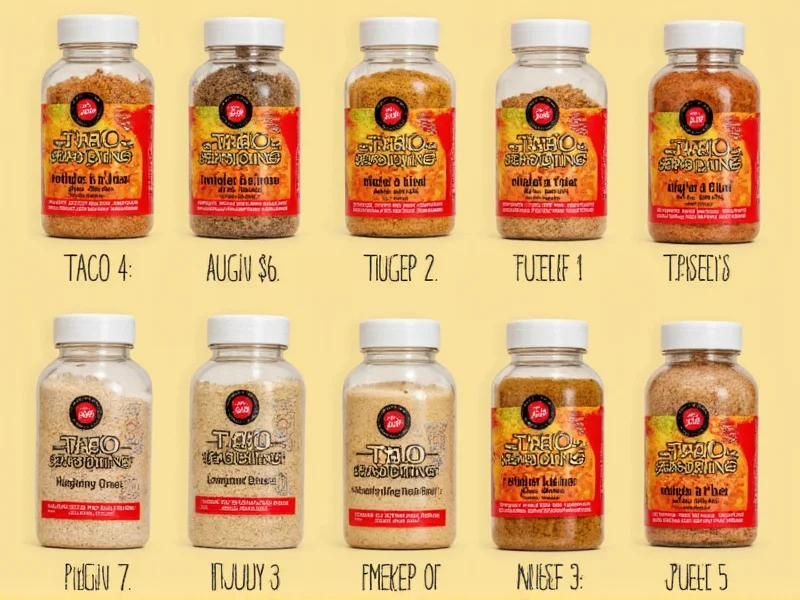If you've ever stood in your kitchen wondering how many tablespoons taco seasoning in a packet, you're not alone. This simple measurement question matters when you're following a recipe precisely or substituting homemade taco seasoning for store-bought packets. Let's break down the facts you need for perfect taco night.
Standard Taco Seasoning Packet Measurements
When examining popular brands like McCormick, Old El Paso, and Lawry's, we find consistent measurements across most commercial products:
| Brand | Packet Size | Tablespoons | Teaspoons | Weight |
|---|---|---|---|---|
| McCormick | 1 packet | 2.25 | 6.75 | 0.9 oz (25g) |
| Old El Paso | 1 packet | 2 | 6 | 0.8 oz (22g) |
| Lawry's | 1 packet | 2.5 | 7.5 | 1 oz (28g) |
| Generic Store Brand | 1 packet | 2–2.5 | 6–7.5 | 0.8–1 oz (22–28g) |
Why Taco Seasoning Packet Measurements Vary
The variation in how many tablespoons in a taco seasoning packet comes down to three factors:
- Density differences - Finely ground spices pack more tightly than coarser blends
- Brand formulations - Some recipes contain more salt or filler ingredients
- Packaging standards - Manufacturers measure by weight (ounces), not volume (tablespoons)
When a recipe calls for "one packet" of taco seasoning, it's referencing the standard 1-ounce measurement, not a specific volume. This explains why your tablespoon count might differ slightly between brands even when using the same packet size.
Converting Taco Seasoning Measurements
Understanding these conversions helps when you're substituting homemade taco seasoning for store-bought packets or adjusting recipes:
- 1 ounce = 2–2.5 tablespoons (most commonly 2.25 Tbsp)
- 1 tablespoon = 3 teaspoons
- 1 packet = 6–7.5 teaspoons
- 1 cup = 4–5 packets (depending on brand)
When making your own taco seasoning to replace a commercial packet, use 2–2.5 tablespoons of your homemade blend. Start with 2 tablespoons if you prefer milder seasoning, or 2.5 tablespoons for bolder flavor.
Practical Tips for Using Taco Seasoning Packets
Here are some professional kitchen-tested recommendations when working with taco seasoning packet measurements:
- Don't eyeball it - Use proper measuring spoons for accuracy, especially with small quantities
- Adjust to taste - The standard packet measurement assumes average palates; increase or decrease based on preference
- Consider your protein - Use the full measurement for 1 pound of meat, but reduce slightly for delicate proteins like fish
- Account for other seasonings - If your recipe already includes cumin or chili powder, reduce the taco seasoning slightly
Troubleshooting Common Measurement Issues
When your taco seasoning doesn't taste quite right, the problem often relates to measurement errors:
Too salty? Many commercial packets contain significant salt. If using a salted packet with additional salt in your recipe, reduce other salt sources. Most packets contain about 400–500mg sodium.
Not flavorful enough? You might be using less than the standard 2–2.5 tablespoons. Try increasing by 1/4 tablespoon increments until you reach your preferred taste.
Overpowering spices? Some brands have stronger chili components. If this happens, balance with additional tomatoes, beans, or dairy products like sour cream.
When Homemade Mixes Replace Packets
If you're making your own taco seasoning instead of using packets, this basic ratio works as a direct substitute:
- 2 tablespoons chili powder
- 1 teaspoon cumin
- 1/2 teaspoon paprika
- 1/2 teaspoon garlic powder
- 1/4 teaspoon oregano
- 1/4 teaspoon onion powder
- 1/4 teaspoon red pepper flakes (optional)
- 1/2 teaspoon salt
- 1/4 teaspoon black pepper
This blend equals approximately 2.25 tablespoons total, matching the standard taco seasoning packet measurement. Store any extra in an airtight container for up to 6 months.
Final Measurement Recommendation
For the most reliable results when following recipes that specify "one packet" of taco seasoning, measure out 2.25 tablespoons (6–7 teaspoons) of your seasoning blend. This accounts for the average density across most commercial products and provides consistent flavor in your dishes.
Frequently Asked Questions
How many tablespoons are in a standard taco seasoning packet?
Most standard taco seasoning packets contain 2–2.5 tablespoons of seasoning, with 2.25 tablespoons (6.75 teaspoons) being the most common measurement for a 1-ounce packet.
Can I substitute homemade taco seasoning for a store-bought packet?
Yes, use 2–2.5 tablespoons of your homemade taco seasoning blend to replace one standard store-bought packet. Start with 2 tablespoons for milder flavor or 2.5 for stronger seasoning.
Why do taco seasoning packet measurements vary between brands?
Measurements vary due to differences in spice density, brand formulations (some contain more salt or fillers), and packaging standards (manufacturers measure by weight, not volume).
How many teaspoons are in a taco seasoning packet?
A standard taco seasoning packet contains 6–7.5 teaspoons of seasoning, with 6.75 teaspoons (2.25 tablespoons) being the most common measurement.
How much meat does one taco seasoning packet season?
One standard taco seasoning packet (1 ounce or 2–2.5 tablespoons) is designed to season approximately 1 pound of ground meat, which typically makes 4–6 tacos.











 浙公网安备
33010002000092号
浙公网安备
33010002000092号 浙B2-20120091-4
浙B2-20120091-4